
Obtaining Food at Sea Menu: 1 2 3 4 5 6 7 8 9 10 11 Next>>
Obtaining Food at Sea During the Golden Age of Piracy, Page 2
Obtaining Food at Sea in the Late 17th and Early 18th Centuries - Gifts
Local government officials sometimes sent gifts to the officers on ships who stopped at their ports, most likely to encourage them to trade with the merchants there. Ships that wanted food would have been an source of revenue to those who could supply them. There are 12 examples of this in the sailors accounts under study and they include sailors from every type of ship: naval, merchant, buccaneer and privateer. This includes a single example from a golden age pirate, although it is a bit different than the other accounts.
There are two examples of an English navy vessel receiving gifts
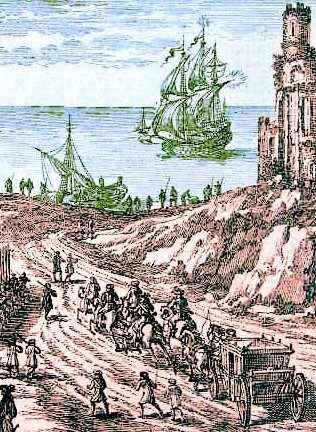
Meeting the Ship, From Description de l'Univers,
By Alain Manesson Mallet (1683)
in the sailor's accounts under study, which should not be entirely surprising. As already explained, the navy tried to follow a pretty specific dietary plan with an allowance for their before mast men. There were some similarly specific local substitutions allowed where it was easier (and theoretically cheaper) to get foods not readily available, but they were in line with the foods they replaced. In order to maintain this diet, the navy set up several victualling stations and victualling agents (which are discussed in other articles) whom they typically dealt with rather than relying on the vagaries of the local markets to supply them with provisions. The first example comes from sailor Samuel Atkins, who reported that the HMS Crown stopped at Ventotene Island, Italy in February of 1681 where "[t]he Governour presented ye Captaine with a small sallett and a few oranges"1.
The second comes from navy surgeon John Atkins on HMS Swallow, one of navy two ships who sailed with some of the merchants of the Royal African Company and as well as other navy ships. They arrived in Sesthos (modern Cape Palmas, Liberia) in May of 1721, where the local king "sent us a couple of Goats" in recognition of their giving his sons titles.2 It should be noted that this is more of an exchange in recognition for the honor they paid the king than a true gift. (However, it has still been counted here.)
Most of the gifts of food presented by local officials were just token offerings indicating their regard for the ship's captain or master and perhaps indicating the type of the foods the location might offer to a crew weary of salt and dried victuals. There are two examples of relatively small gifts of food mentioned in the merchant ship accounts. The first comes from chaplain Henry Covel who stated that when the Levant Company's ship London Merchant sailed into the harbor at Tenedos (now called Bozcaada, an island off Turkey) where the local agha (a government official) "sent us some fish" which included a breame that Covel described in great detail.3 The other food gift to a merchant vessel comes from the East Indiaman Scepter which had stopped at Mocha, India in 1697. Edward Barlow, chief mate of the vessel, explains that "the Governor sent after us his present, being three small sheep and some green herbs and limes and some fruits, which we accepted and gave the messenger a gratuity."4 It seems likely that the practice of gift giving to merchant vessels would have been far more prevalent than these two examples suggest. It is notable that in both instances, the men reporting the gifts were officers on their ship, which may explain why there are not more examples described by regular merchant sailors.
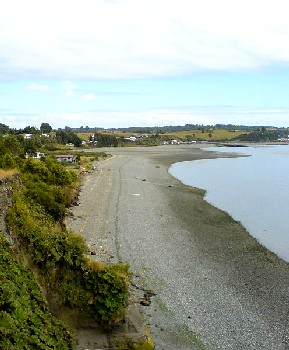
Photo: Jorge Morales Piderit - The Cost of Chacao Chile
The single example of a privateer receiving gifts from a local official occurred because the captain misrepresented the nationality of his ship to the local Spanish governor. After the Speedwell made the trip around Cape Horn in late 1719, Captain George Shelvocke was in need of provisions. He anchored at Chacao, Chile and sent a note to the local governor, Don Nicolas Salvo, representing the ship as a French vessel on its way home. Because Shelvocke was not French, he couldn't actually meet with the governor without the ruse being discovered, so they communicated via a series of letters. Salvo was suspicious of Shelvocke's ship, as seen in his first letter:, "having orders from my King not to supply any foreign ships with provision, I cannot order what you have desired of me. I thank you for the compliment of drinking my health, and have sent you a dozen of hams, as the fruit of this country, and as fruit only I have taken that liberty."5 Following several more letters, the crew abandoned diplomacy, went ashore and took what they wanted.
The majority of examples of gifts being sent to a ship come from the buccaneer accounts. Several mention the governor of Guam sending gifts to the ships in the 1680s. These come from the accounts of William Dampier and William Ambrosia Cowley. Both arrived in Guam on their way to the East Indies following successful raids of South and Central America after crossing the Pacific Ocean. Like some of the other instances, these are not pure examples of gifts from the locals since both involved some conflict between the crews and the governor. However, they both refer to the exchanges as gifts so they are included here.
Cowley was sailing with Captain John Cook on the ship Revenge which arrived in Guam on March 14, 1685. When they arrived, they first traded with the locals. The buccaneers were eventually attacked by them, resulting in some of the natives being killed.
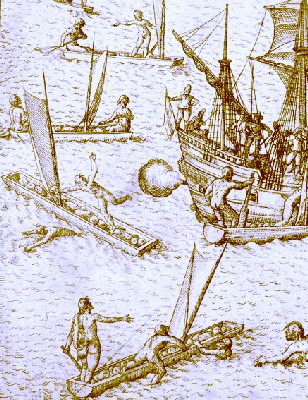
Artist: Theodor de Bry
Attacking Natives Who Were Trading [Ladrones/Marianas] (1603)
The governor demanded to know who they were and they wrote back saying they were French explorers. The went ashore where the Spanish fired at them, resulting in the buccaneers firing ten guns back. "We quickly came to a right understanding one with another, and satisfied the Governor"6. On the 18th, Cowley says that the governor sent a Spanish captain aboard the Revenge who "brought us 10 Hogs, abundance of Potatoes, Plantans, Oranges and Papaes, and red Pepper, in token of their Friendship"7. Four days later, Cowley says the governor sent a boat to them which "brought us some Coca Nuts, Potatoes and Chocalate" along with a Jesuit priest who taught them how to get milk from the coconuts.8 The last mention of gifts from Guam in his book says that the governor "sent us moreover, the succeeding days... thirty Hogs, some Pomkins, green Trade [green vegetables, often salads], Potatoes and Rice, as a Present."9
William Dampier was sailing from the Americas with Captain Charles Swan on the Cygnet when they arrived in Guam a little over a year after Cook on May 20th, 1686. Their experience was similar to that of their predecessor, although Dampier described the governor's 'presents' like ransom payments. The Cygnet had captured a priest from a group who had come aboard thinking their ship was Spanish and held him hostage. Swan "was willing to detain him as an Hostage, till we had Provision. The Padre told Capt. Swan, that Provision was now scarce on the Island, but he would engage, that the Governour would do his utmost to furnish us."10
Dampier reported that the next day, the governor on Guam "sent a present of 6 Hogs, of a small sort, most excellent Meat, the best I think, that ever I eat" in addition to "12 Muskmelons, larger than ours in England, and as many Water-melons, both sorts here being a very excellent Fruit; and sent an order to the Indians that lived in a Village not far from our Ship, to bake every day as much of the Bread-fruit as we did desire, and to assist us in getting as many dry Coco-nuts as we would have"11. He then noted that the governor continued to send them "every day a Canoa or two with Hogs and Fruit" along with baked bread fruit.12 Dampier finishes by explaining,
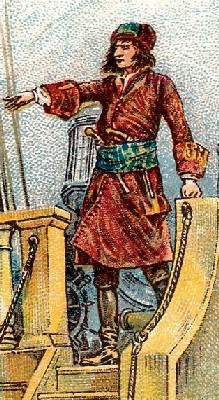
William Dampier, From Carreras Cigarette
Cards, Highwaymen Series, #6 (1924)
The 30th Day of May, the Governour [of Guam] sent his last Present, which was some Hogs, a Jar of pickled Mangoes, and Jar of excellent pickled Fish, and a Jar of fine Rusk, or Bread of fine Wheat-Flower, baked like Bisket [sea biscuit - twice baked], but not so hard. He sent besides six or seven Packs of Rice, desiring to be excused from sending any more Provison to us, saying he had no more on the Island that he could spare.13
Since the provisioning stopped along with the fact that the governor warned them that the monsoon season was approaching, Swan decided it was time to depart. "Captain Swan returned him [the governor] thanks for his kindness and advice, and took his leave"14. The food supply had not completely dried up yet, however. After they released the Jesuit who had been their hostage, he "sent us aboard six Hogs, and a roasting Pig, 3 or 4 Bushels of Potatoes, and 50 pound of Manila Tobacco."15
Dampier also reported that when they stopped at one of the 'Piscadores Islands' [modern Penghu, Taiwan] in 1687, an "Officer brought aboard, as a Present from the Governour, a young Heifer, the fattest and kindliest Beef, that I did ever taste in any foreign Country; ‘twas small, yet full grown; two large Hogs, four Goats, two Baskets of fine Flour, 20 great flat Cakes of fine well-tasted Bread, two great Jars of Arack (made of Rice as I judged)"16. Unlike their experience in Guam, where the governor was under some duress to provide food, these things were more in line with the smaller gifts given in other examples.
The one example of a pirate and gifts of food actually involves them sending the food to the governor of Porto Santo, one of the Madeiras Islands owned by Portugal in 1724. Wanting the right to trade for food, pirate captain John Gow "sent their Boat ashore with Captain Somerville’s Bill of Health, and a Present to the Governor of three Barrels of Salmon, and six of Herrings, and a civil Message, desiring Leave to water and buy Refreshments, on Pretence of being bound to the West-Indies."17 The bill of health was from a ship they had taken, a necessary item to prove they were free of the plague or other communicable diseases so that they would be given pratique - permission to come ashore. Unfortunately for the governor, he decided to visit their ship, resulting in the pirates holding him hostage until they got the food and water they wanted. While there are other examples of ship captains giving gifts to local officials, they are usually not gifts of food, probably because they would not have much to spare.
1 Samuel Atkins, "A Sailor's Journal", Colburn's United Service Magazine, Part 1, 1854, p. 207; 2 John Atkins, A Voyage to Guinea and Brazil, 1735, p. 66; 3 John Covel, "Extracts from the Diaries of Dr. John Covel, 1670-1679," Early Voyages and Travels in the Levant, edited by J. Theodore Bent, 1893, p. 142; 4 Edward Barlow, Barlow’s Journal of his Life at Sea in King’s Ships, East and West Indiamen & Other Merchantman From 1659 to 1703, p. 480; 5 George Shelvocke, A Voyage Round the World by Way of the Great South Sea, 1726, p. 86; 6,7 William Ambrosia Cowley, "Cowley’s Voyage Round the Globe", A collection of original voyages, William Hacke, ed., 1993, p. 16; 8 Cowley, p. 17; 9 Cowley, p. 19; 10 William Dampier, A New Voyage Round the World, 1699, p. 301; 11,12 William Dampier, A New Voyage Round the World, 1699, p. 302; 13,14 Dampier, p. 303; 15 Dampier, p. 304; 16 Dampier, p. 419; 17 Charles Johnson, A General History of the Pyrates, Shonhorn, ed., 1999, p. 361
Obtaining Food at Sea in the Late 17th and Early 18th Centuries - Sharing
Of all the methods for obtaining food, the sailing literature under study produces the fewest examples or sharing between ships. There are only 6 of them, one of which comes from a buccaneer account; the rest come from pirates accounts. Food was one of the elements which limited how far and long a ship could sail (in addition to alcohol and water). It didn't help that food nearly always went bad eventually. So it should not be surprising that when the English navy collected and published all the rules and guidelines in 1731 under the title Regulations and instructions relating to His Majesty's service at sea, sharing of food was strictly governed.
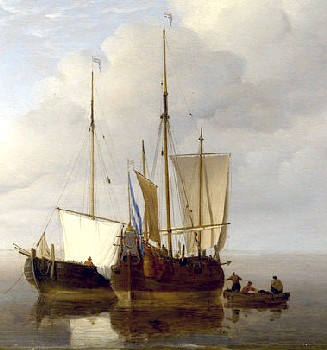
Artist: Willem van de Velde II
Provisioning, From Dutch Ships in a Calm (c. 1660)
"He [the captain] is not to spare any Provisions or Stores to any of His Majesty's Ship's, but where the Necessity is evident, and by Direction of his Commanding Officer, and always to give his Officers a Warrant in Writing for it."1 Some of this strictness came about because the navy was trying to get a handle on the victualling process and remove systematic cheating by those in charge of it, but the term 'where Necessity is evident' speaks volumes.
After capturing and plundering a Spanish vessel of Cabo Blanco in Costa Rica in September of 1680, buccaneer captains John Cox and Bartholomew Sharp, "cut her Main-mast by the board, put most of our Prisoners on board her, gave them six packs of Flower, and all the Provisions that were taken in the Skip, and turned them loose."2 The 'Skip' was a vessel they had taken before the one from which the prisoners had been captured. In this example, they were providing the prisoners they were releasing with provisions so that the crew would not die of hunger.
Henry Every's pirates took a Portuguese slaver off Cape Lopez in what is today Gabon, Africa in 1694. The account explains that "they tooke some Cloathes and silkes from them [the crew of the slave ship] and gave them some provisions which they were in want of"3. A third example of this comes from Captain Thomas White, who who took the Malabar in the early 1700s off Ethiopia. The pirates' ship was so damaged in taking the Malabar that the they "did not think her longer fit for their Use, therefore filled her with Prisoners, gave ’em Provision, and sent them away."4 The final example comes from another Indian Ocean-based pirate, John Bowen who took the Speaker off Madagascar in
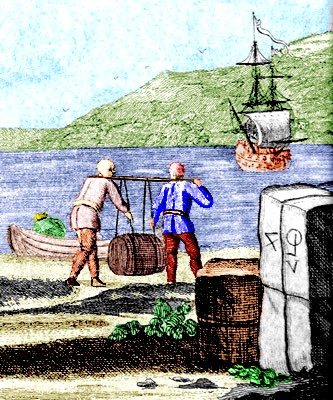
Artist: Joseph Nicholls
Loading a Ship, From The General History of the Pyrates (1736)
1701, deciding to make it their new vessel. "The next Day they put necessary Provisions on board the French built Ship [which they had previously captured], and gave her to the Captain of the Speaker"5. So the majority of the instances of sharing food come from pirates and buccaneers showing compassion to their victims.
The other two examples are instances of pirate crews sharing food with each other. The first is from the account of pirate captains John Bowen and Thomas Howard. Bowen and Howard had been sailing in consort but got separated during a storm. The storm caused Bowen's crew to throw their guns and some provisions overboard in an effort to lighten their ship and prevent it from sinking. Although their consortship was nearing its proposed end in the fall of 1703, "Captain Howard spared them some fresh Provisions, and expressing great Concern for the Accident, renewed his Consortship for two Months longer"6. The final example of food share is the only instance that comes from pirates based in the Atlantic Ocean. Like Howard and Bowen, pirates Edward Low and George Lowther had been sailing in consort when, after capturing the Rebecca in May of 1722, Low and forty-four of the crew decided to leave Lowther. "They took with them two Guns, four Swivels, six Quarter-Casks of Powder, Provisions and some Stores, and so left Lowther to prosecute his Adventures"7.
1 Regulations and instructions relating to His Majesty's service at sea,1st ed., 1731, p. 26; 2 Basil Ringrose, The Adventures of Capt. Barth. Sharp, And Others, in the South Sea, 1684, p. 26; 3 “63. Examination of John Dann. August 3, 1696., Privateering and Piracy in the Colonial Period – Illustrative Documents, John Franklin Jameson, ed., 1923, p. 166; 4 Daniel Defoe (Charles Johnson), A General History of the Pyrates, Shonhorn, ed., 1999, p. 484; 5 Defoe (Charles Johnson), p. 478; 6 Defoe (Charles Johnson), p. 522; 7 Defoe (Charles Johnson), p. 319-20

